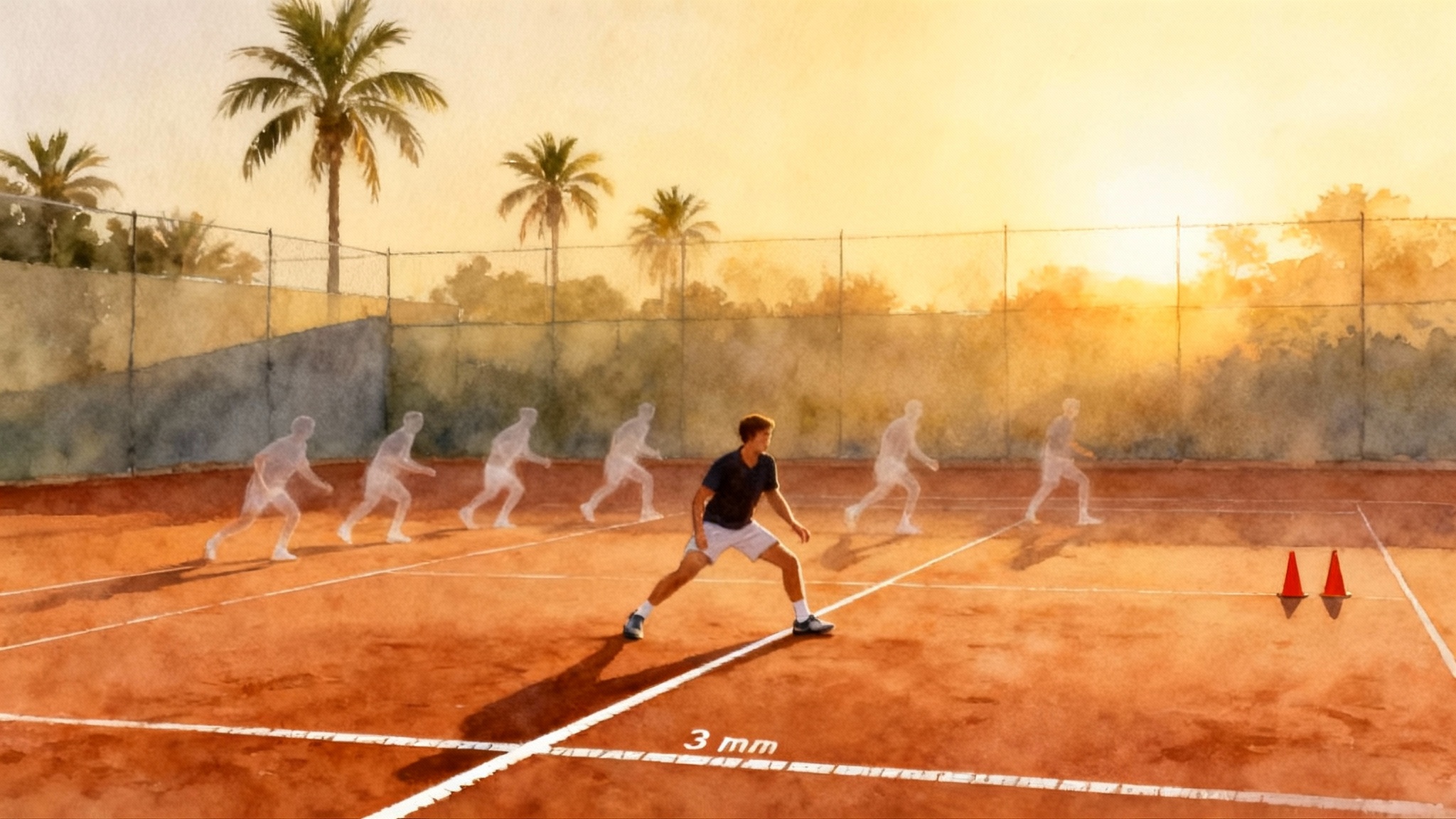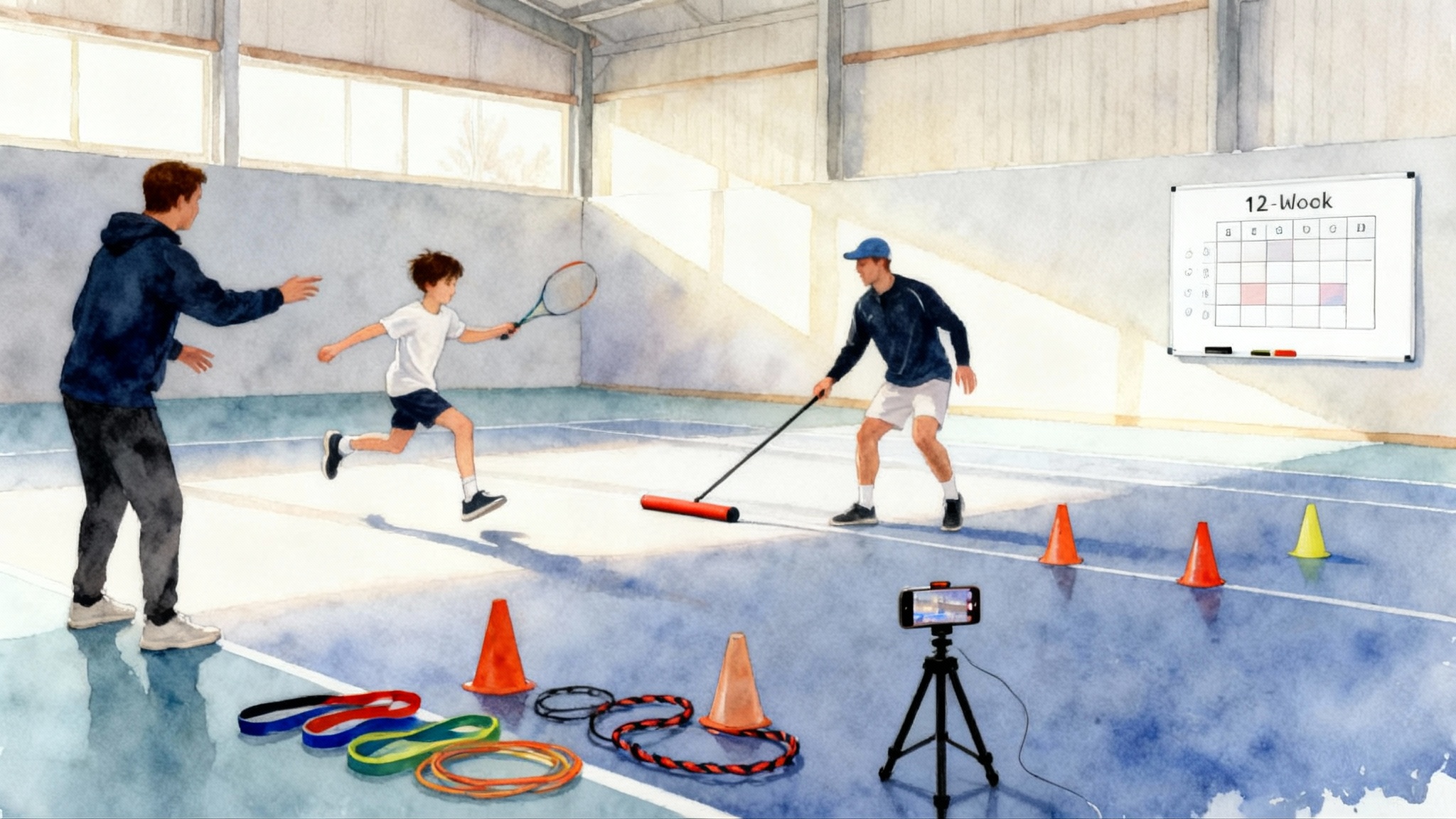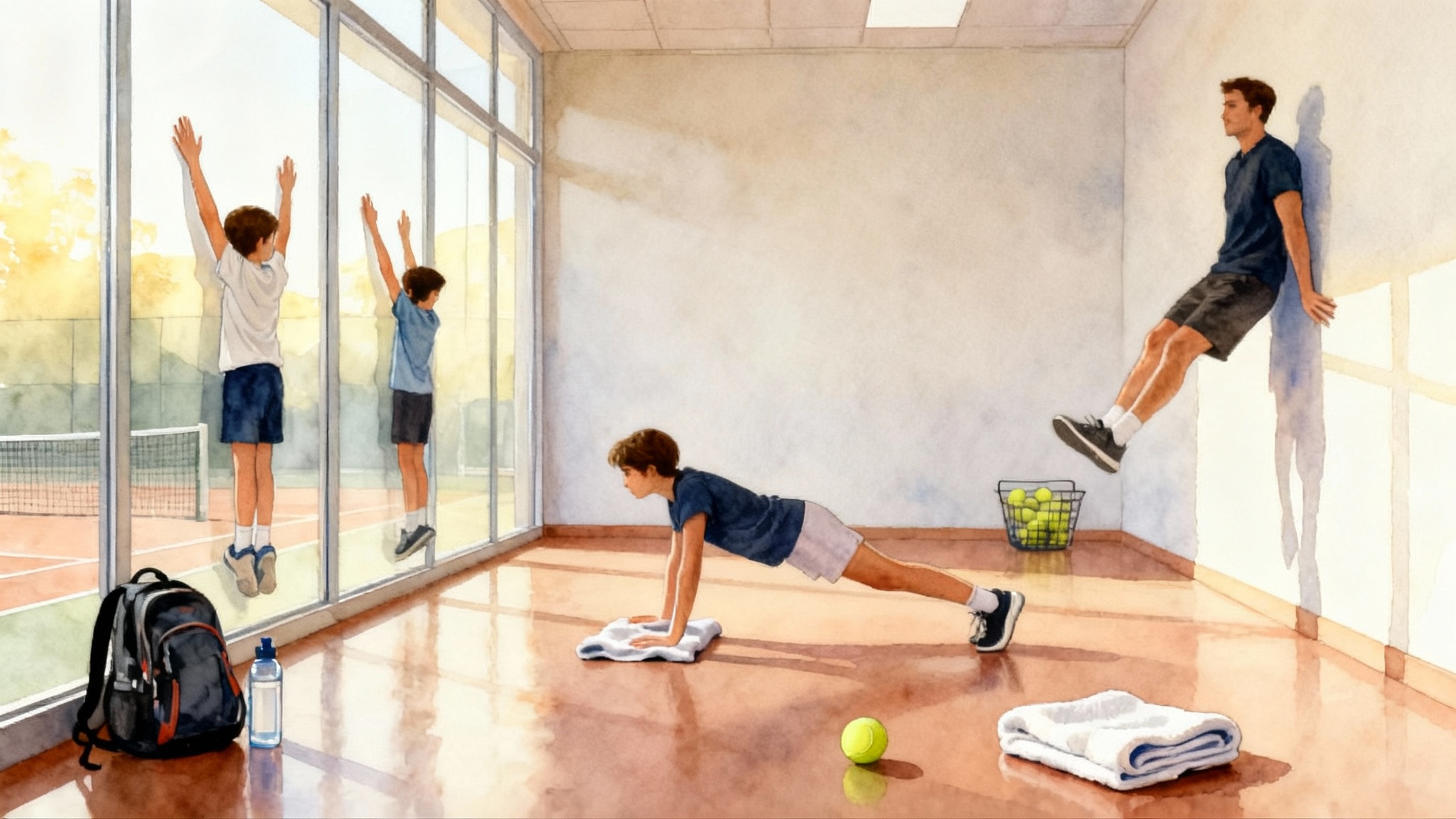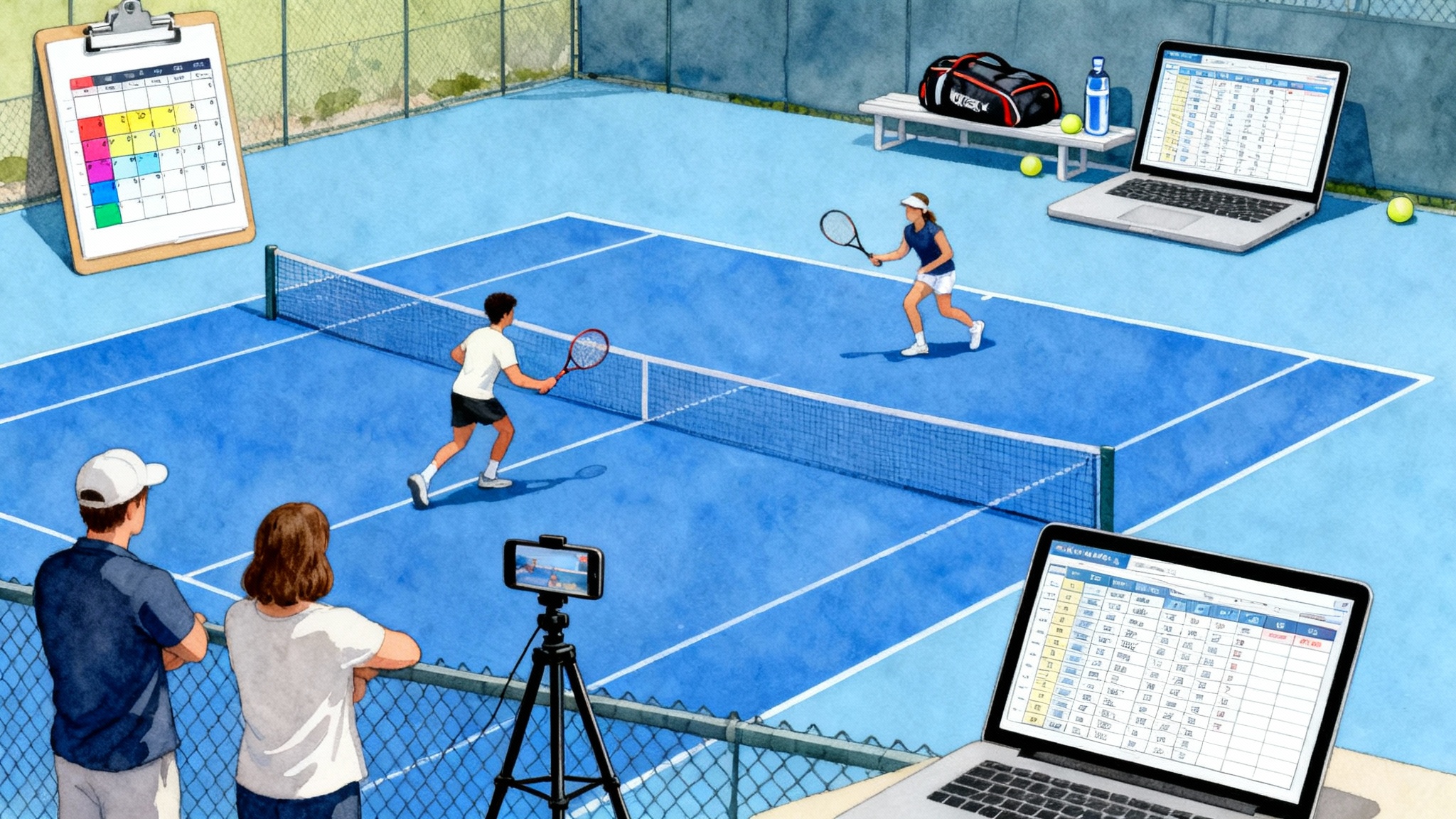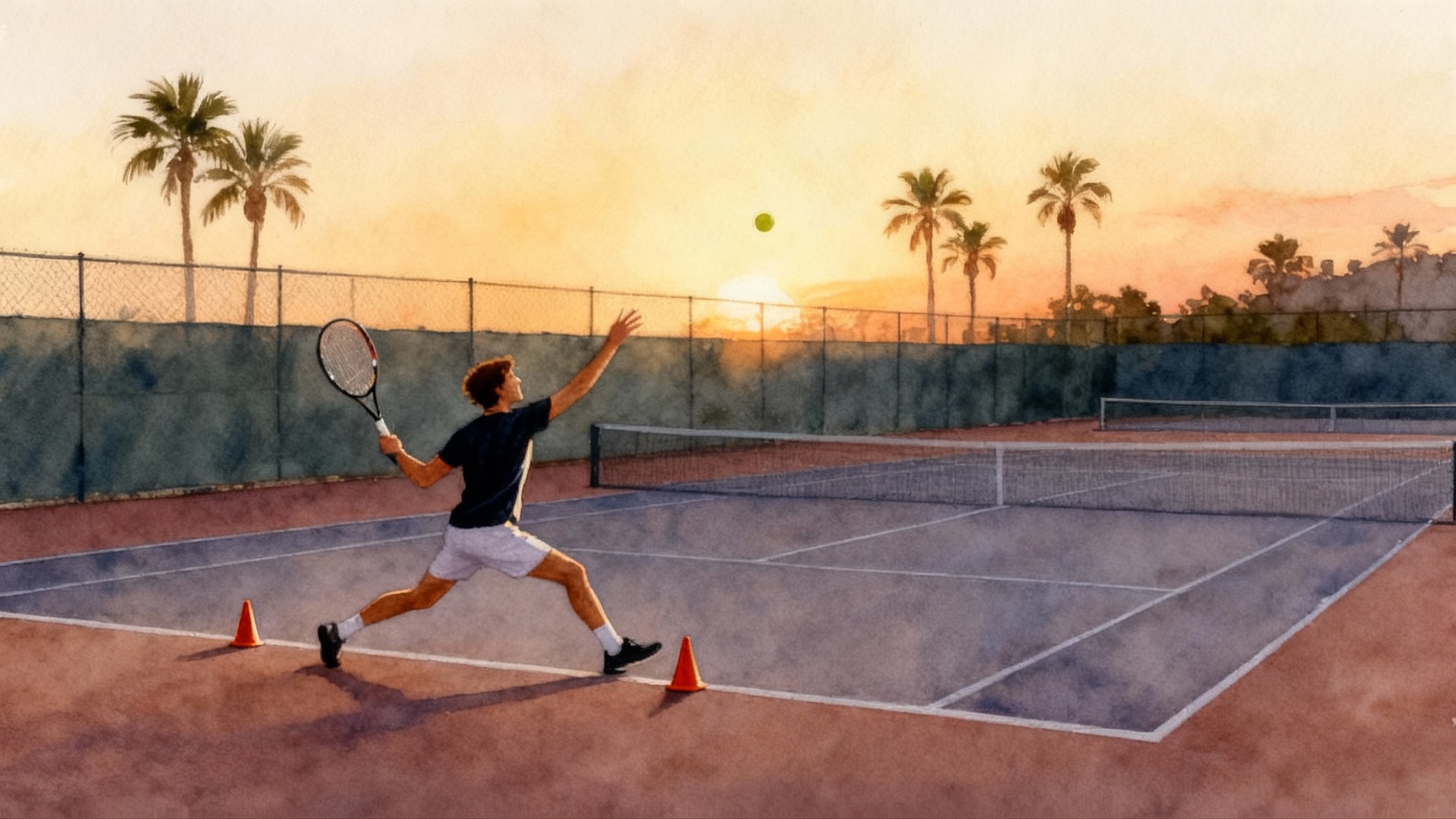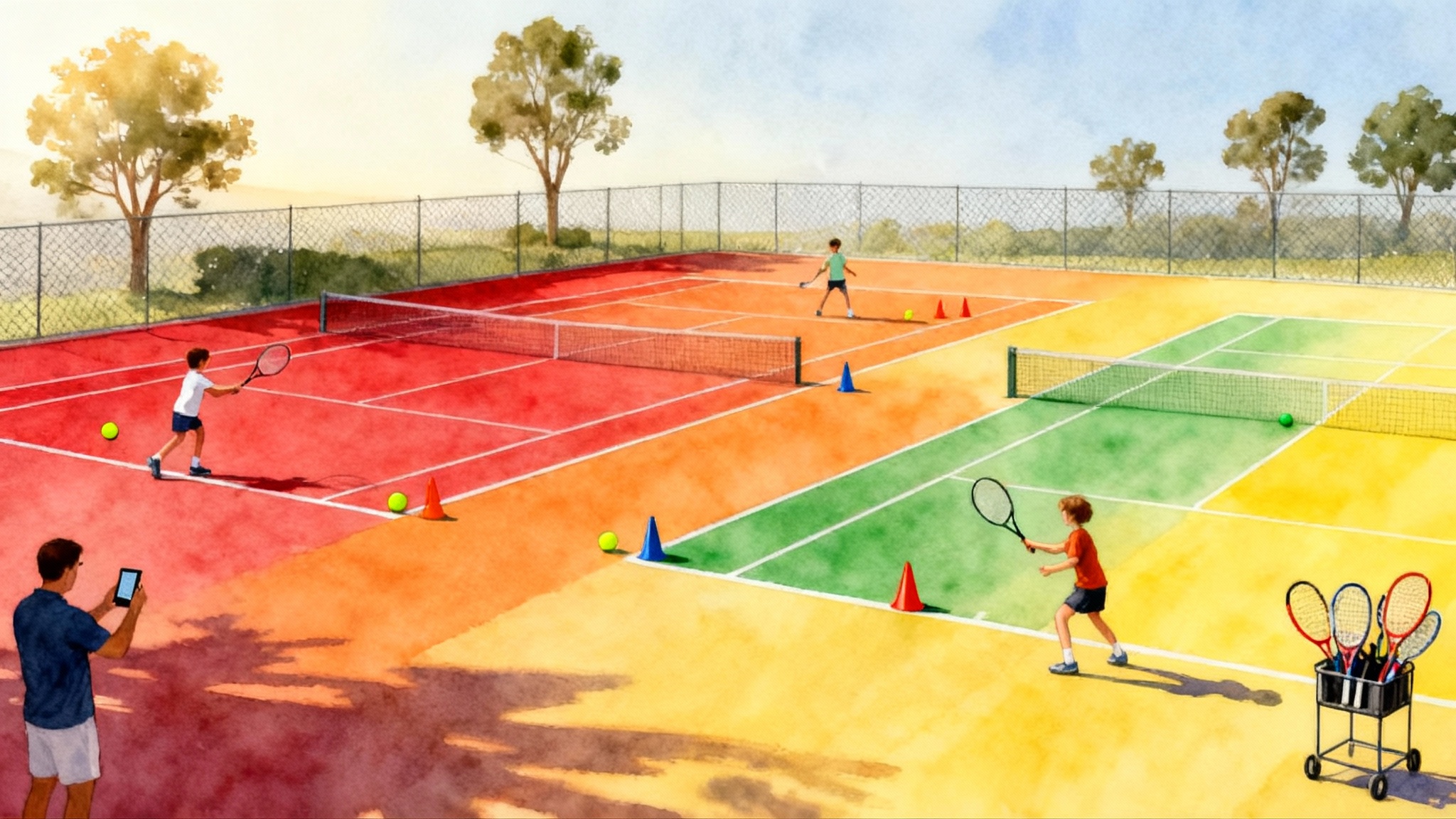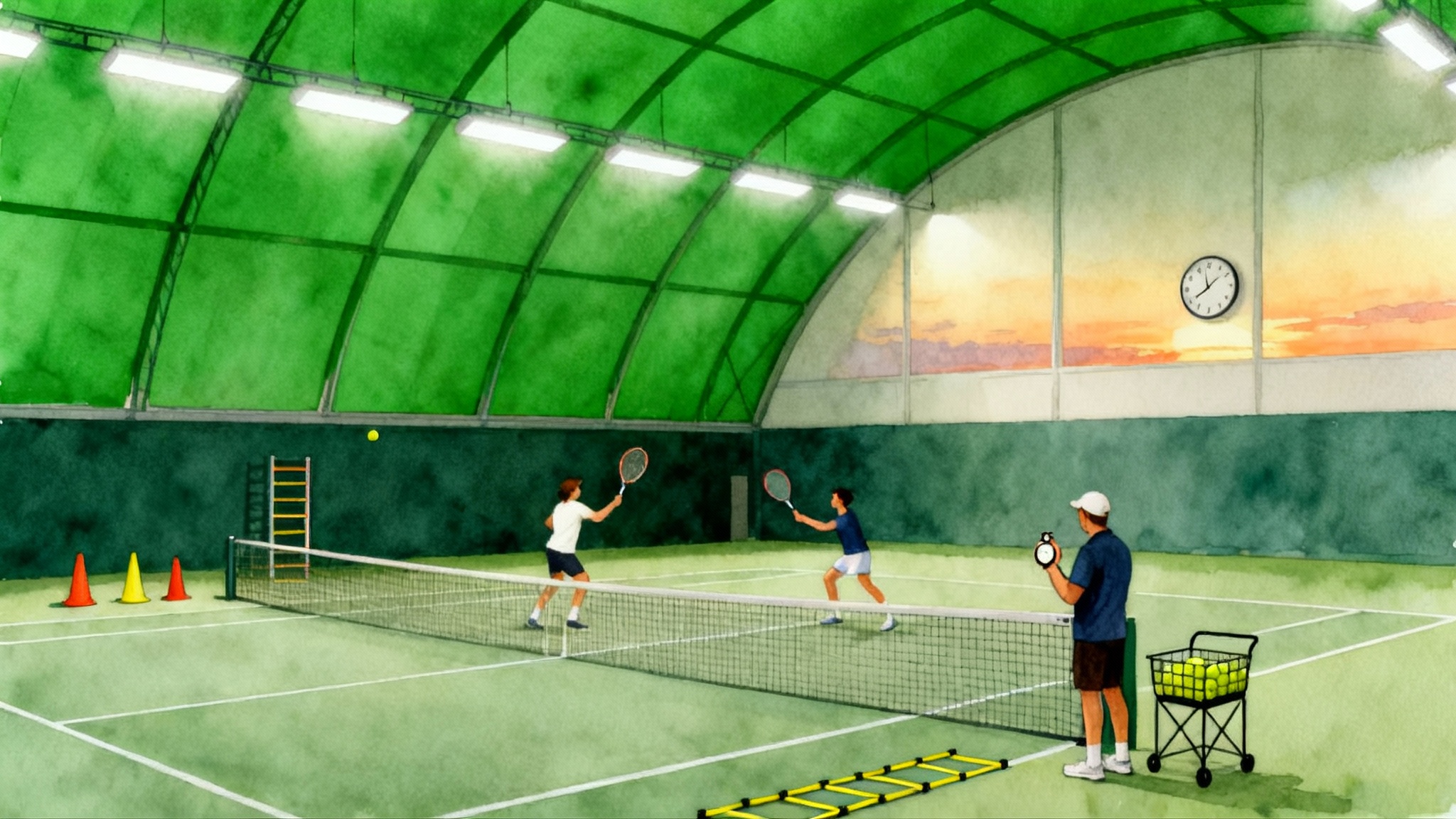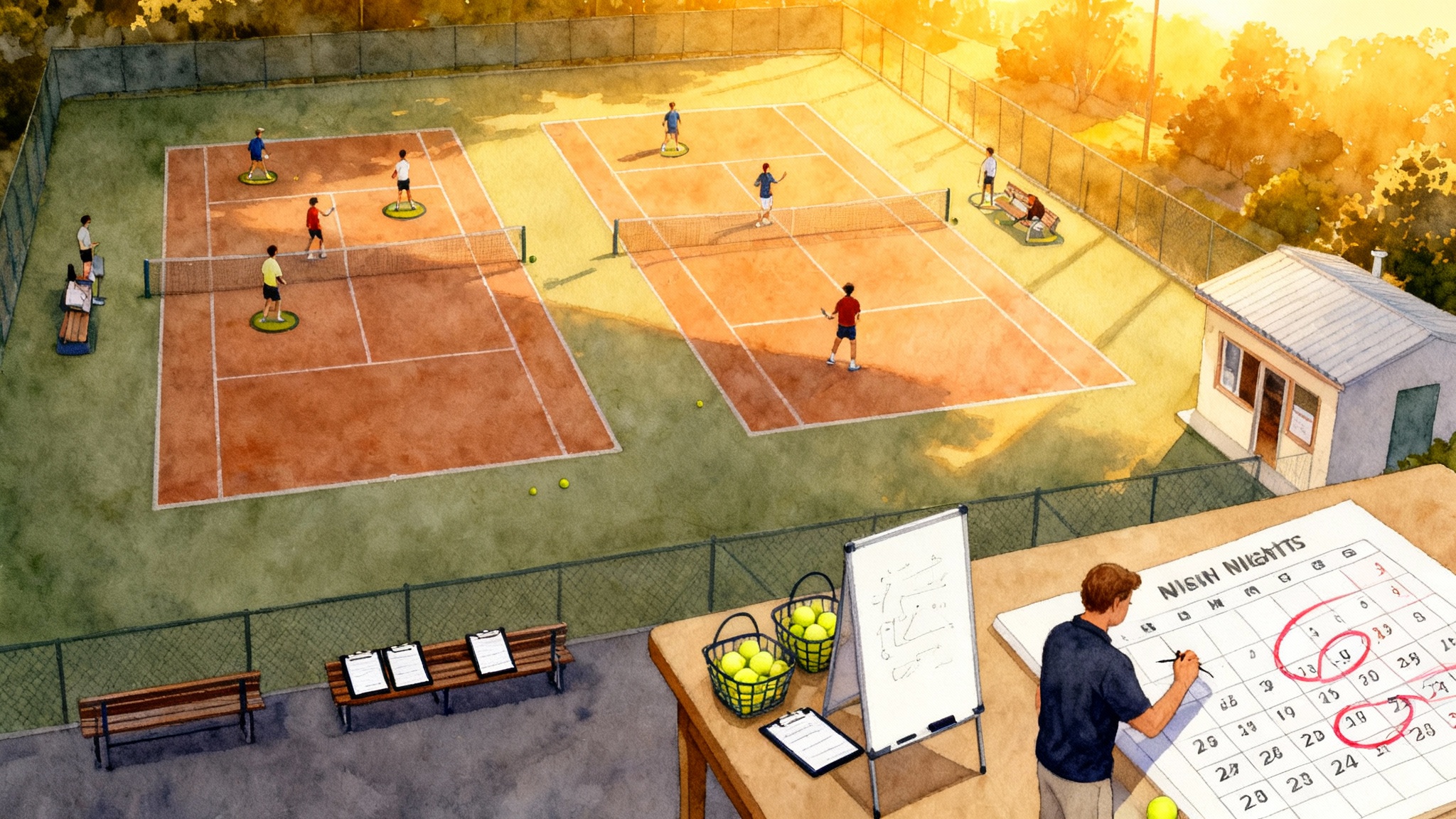Tennis Video Analysis 2025–26: Smart‑Court and Phone Playbook
A practical, step by step guide for juniors, parents, and adult players to film, tag, and turn tennis video into better technique and more wins in 2025–26, with smart court and smartphone setups, drills, and checklists.
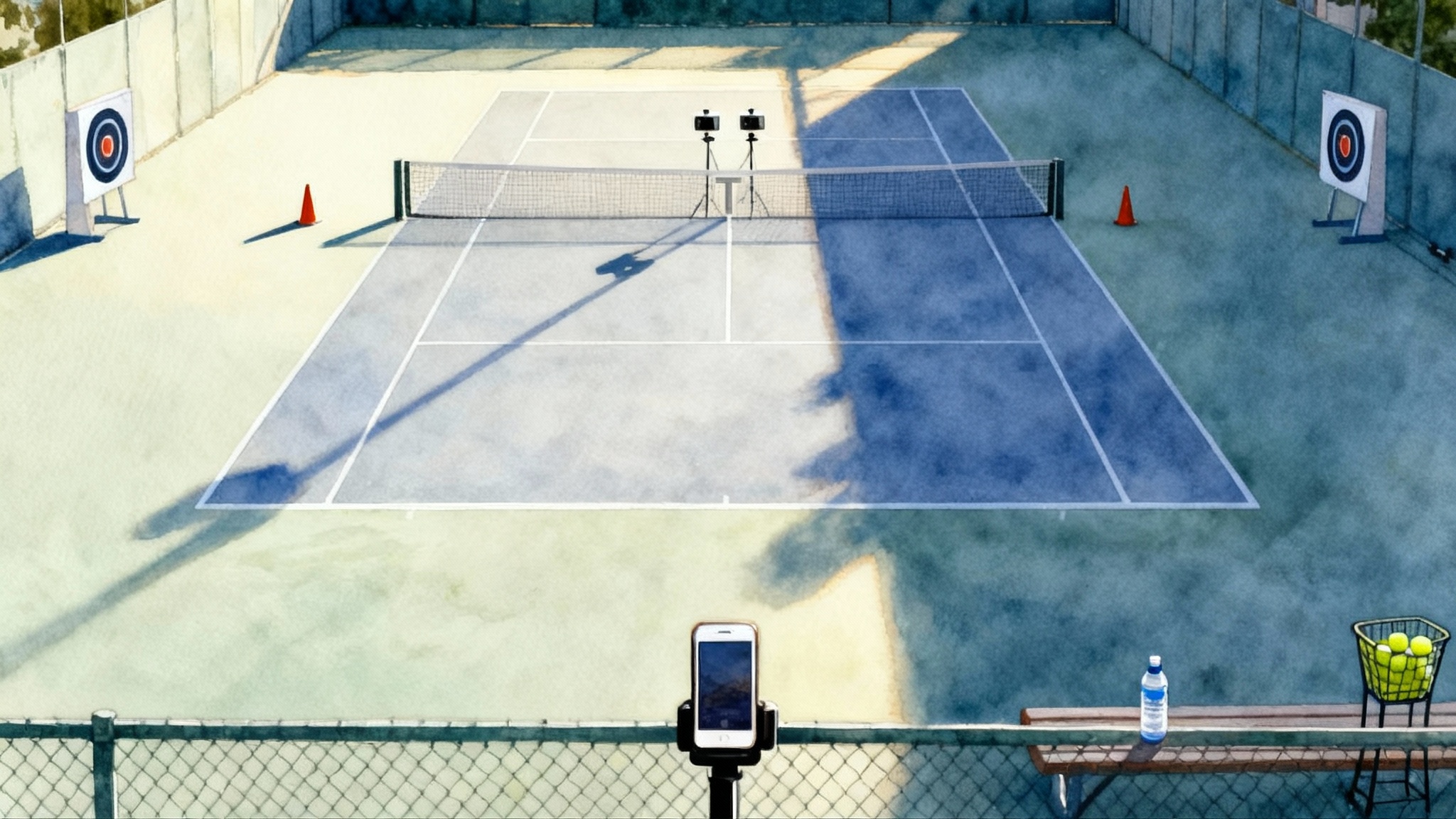
Why video beats memory in 2025–26
After a match, most players remember two or three highlight points and one painful miss. Video replaces selective memories with facts you can act on. Smart courts and smartphones now make it simple to capture every point, tag the moments that matter, and convert patterns into training sessions. Systems like PlaySight smart courts record, auto cut, and enable tagging so you see exactly where points are won or lost, not where you only felt momentum swing. See how a smart court works on the official PlaySight page for smart court video and analytics.
You do not need a smart court to start. Your phone and a $30 fence mount will do. The gold standard is two angles that make tactical and technical patterns plain even to a first time viewer. Below you will learn how to set them up in minutes. For return-specific improvements, see Return of Serve reads and patterns.
The two camera angles you need
You will get 80 percent of the value from two angles. Add more only after the basics are routine.
1) Baseline view that sees both players
- Purpose: Pattern and decision making. Rally length, depth, serve direction, where errors occur.
- Setup: Place the camera 3 to 4 meters behind the baseline, centered on the singles line, at a height between 2.2 and 2.7 meters to see over the fence. If your fence is high, use the top of a ball hopper on a bench or a fence mount.
- Framing: Include both sidelines and the opposite baseline. Leave a small margin above the back fence so you do not cut off high lobs.
- Settings: 1080p at 60 frames per second for smooth tracking. Lock exposure and focus by tapping and holding on the court surface so brightness does not hunt.
- Pro tip: If sun is low, move slightly off center to avoid lens flare but keep the center service line vertical in view.
2) Server view behind the server
- Purpose: Serve location, toss, contact point, and first move after contact.
- Setup: Place the camera 2.5 to 3 meters behind the server’s baseline on the server’s side, centered on the deuce or ad channel you are working on. Height 2 to 2.5 meters.
- Framing: The entire service box on the far side should be visible with enough sky to see contact. Keep the server’s hitting arm fully in frame throughout the motion.
- Settings: 1080p at 120 frames per second if your device supports slow motion. Audio on, since footwork and rhythm cues matter.
- Pro tip: Use a tiny piece of contrasting tape on the net cord where the T meets the net to make aim lines clearer on video.
What to film each week
- One 20 to 30 minute rally practice from the baseline view, with patterns like crosscourt forehand, backhand crosscourt, forehand inside out to backhand, and short ball approach.
- One 15 to 20 minute serve session from the server view, alternating deuce and ad sides in blocks of 10 first serves and 10 second serves.
- Optional: One practice set or a match tiebreak from the baseline view.
Keep the camera rolling. Do not stop between drills. Long continuous clips are easier to tag quickly.
Starter tag sheets that work for everyone
You do not need complex software to tag. You can begin with a paper sheet or a phone note. If you want automatic tagging on a phone, SwingVision on iPhone and iPad can detect rallies and basic stats, which makes hand tagging faster. Learn more from the official site for SwingVision automatic tagging.
Here is a simple tag set you can copy into Notes or print.
Rally length
- 0 to 4 shots: short rally
- 5 to 8 shots: medium rally
- 9 plus shots: long rally
Tag the rally length for every point in a practice set or for a five minute block of drilling.
Serve location
- Deuce side: wide, body, T
- Ad side: wide, body, T
Mark first serve and second serve separately. Circle any double fault.
Contact point timing on groundstrokes
- Early: contact clearly in front of the front hip
- On time: contact level with the front hip
- Late: contact clearly behind the front hip
Also tag spacing if obvious: jammed, optimal, or over extended.
Ball depth by four zones
- Zone 1: short, lands in the service boxes
- Zone 2: mid, lands between service line and the last 2 meters before the baseline
- Zone 3: deep, lands in the last 2 meters before the baseline
- Zone 4: very deep, lands within 1 meter of the baseline or on the line
Unforced error types
- Footwork: slow first step, off balance, wrong split timing
- Spacing: too close to the ball or too far
- Preparation: late racquet set or short backswing that forced a push
- Decision: wrong target, wrong spin, low percentage at that score
- Execution: clean miss despite correct decision and prep
Add the stroke next to the cause, for example “UE, spacing, forehand crosscourt.”
How to tag in 15 minutes without getting lost
- Watch on 1.25 to 1.5 speed. You will still see patterns clearly.
- For rally sessions, tag only the ball that ended the point, the rally length, and ball depth of that last ball. Add a quick cause if it was an unforced error.
- For serve sessions, tag serve location and whether the serve won the point directly, forced a short ball, or led to a neutral rally.
- For one technical focus per week, add a second tag. Example: for backhand work, tag contact timing on that stroke only.
- Stop after 15 focused minutes. If you try to tag everything, you will do it once and never again.
Making sense of tags: two simple summaries
You need only two mini reports to turn numbers into actions.
- Point ending map: For the last ball of each point, count how many ended with your forehand, backhand, or serve. Note whether the ball was deep or short and whether it was a winner, forced error, or unforced error.
- First three shots on serve: For serves that landed in, count how often your plus one forehand was deep and crosscourt, deep and down the line, or short. You are mapping your most reliable pattern.
These two summaries tell you where you leak points and what to groove in practice.
Turning insights into a weekly training plan
Pick one tactical theme and one technical theme. Add a small strength piece that supports both. Here are four example plans based on common tag patterns.
Plan A: Too many short balls under pressure
- What the tags said: Rally length medium to long, but balls landing mostly in Zone 2. Unforced errors marked as footwork and spacing.
- Goal: Move contact farther in front and push depth to Zone 3.
- Drills:
- Depth ladder: Crosscourt rally with a cone 2 meters inside the baseline. Only balls that land beyond the cone count.
- Step and rip: Feed a neutral ball, player sets the outside foot, loads, then hits a heavy high forehand to a deep target. Emphasize early unit turn.
- Serve add on: Second serve plus one depth. Serve to body, then forehand crosscourt must land in Zone 3 before the point can play out.
- Strength add on, 10 minutes: Lateral bound to stick, three sets of five per side, then medicine ball rotational throw, three sets of six per side.
Plan B: First serve lands but does not hurt
- What the tags said: First serve percentage fine, serve location mostly body. Plus one ball often short or into the middle.
- Goal: Move location to T and wide to open space, then attack crosscourt.
- Drills:
- Serve box ladders: Two cones on the T and two cones 80 centimeters from doubles sideline. Alternate 10 serves T, 10 serves wide.
- Plus one live: Coach or partner blocks the return crosscourt. Server’s first forehand must land deep crosscourt before playing out.
- Strength add on, 10 minutes: Overhead med ball scoop toss, three sets of eight, plus band external rotations for shoulder health, two sets of 15.
Plan C: Backhand breaks down when rallies get long
- What the tags said: Long rallies end with backhand unforced errors marked late or jammed.
- Goal: Early preparation and better spacing.
- Drills:
- Two ball call: Feeder calls early or late in the air. On “early” the player exaggerates unit turn as the ball rises. On “late” the player takes one emergency drop step before loading.
- Spacing gate: Two cones create a lane 60 to 80 centimeters from the player’s hitting zone. Player must move so contact occurs inside the lane.
- Strength add on, 10 minutes: Split step repeats, three sets of 20 seconds, then anti rotation press with cable or band, three sets of 10 per side.
Plan D: Winning on serve, losing on return
- What the tags said: On return games, points end in 0 to 4 shots with unforced errors marked decision or execution.
- Goal: Get neutral more often in the first two shots.
- Drills:
- Two target return: On deuce, aim deep crosscourt. On ad, aim deep middle. Only depth matters for 10 minutes.
- Return plus one neutralize: After the return, the next shot must land in Zone 3 to continue the point.
- Strength add on, 10 minutes: Quick switches footwork drill, three sets of 20 seconds, then pogo jumps, three sets of 12.
Parent checklist for juniors
Use this before each filming session. Keep it on your phone.
- Battery above 50 percent and storage has at least 5 gigabytes free.
- Two mounts packed: fence mount and small tripod or clamp.
- Angle 1 behind baseline, Angle 2 behind server. Confirm framing on a test rally.
- Resolution 1080p, 60 frames per second. For serve, use 120 frames per second if available.
- Lock exposure and focus. Airplane mode on to avoid calls.
- Starter tag sheet ready. Choose one technical tag for this session.
- Hold comments during filming. Encourage effort, not outcomes. Save feedback for when you watch clips together.
- After practice, pick five clips that show the week’s theme. Name the file with date and theme, for example “2025-11-05 Depth to Zone 3.”
Adult league player checklist
- Pick one match per week to record from the baseline view in full.
- Warm up camera framing for two minutes, then leave it alone.
- After the match, tag only the final ball of each game and rally length. Add serve location for your service games.
- Choose one drill block from the weekly plans and schedule it within 48 hours.
- If you play two doubles nights, film one singles practice set anyway. Patterns hide in singles that doubles cannot show.
Example workflow from Tenis Kozerki’s smart court program
The Tenis Kozerki smart court program in Poland runs sessions that combine filming, simple tags, and targeted constraints. Here is an example week that reflects how a smart court structure turns video into actions. You can run the same structure on any smart court or with a phone plus a coach or hitting partner.
-
Monday, 60 minutes, smart court baseline view:
- 10 min crosscourt rhythm, tag last ball and depth for each rally.
- 10 min forehand inside out pattern, tag rally length only.
- 10 min backhand crosscourt, tag contact timing on backhands.
- 10 min approach and first volley, tag whether approach landed deep in Zone 3 or short in Zone 1 or 2.
- 10 min practice games to 7, tag unforced error causes only.
- 10 min review at the kiosk, pick three clips to save for the week’s goals.
-
Wednesday, 60 minutes, smart court serve view:
- 15 min deuce T serves, tag location and whether the next ball was deep or short.
- 15 min ad wide serves, same tags as above.
- 15 min second serve plus one, tag depth of plus one ball.
- 15 min serve plus first volley, tag whether the volley was above or below net height at contact.
-
Saturday, 75 minutes, practice set on smart court:
- Film the full set from baseline view.
- Tag only last ball and depth for each point.
- After the set, spend 15 minutes clipping three good points and three problem points.
-
Sunday, 20 minutes, at home:
- Watch the six clips and write two specific goals for next week. Example: “On ad side, second serve to body 50 percent of the time, plus one backhand must be crosscourt deep.”
Why this works: the tags are light, the clips are short, and the weekly loop is repeatable. Smart courts make clipping easier, and the same structure works with a smartphone and discipline.
Filming mistakes that ruin analysis and how to fix them
- Camera too low: Raises the net visually and hides depth. Fix by going above 2 meters.
- Exposure on auto: Brightness pumping makes ball flight hard to see. Fix by tapping and holding to lock exposure on the court surface.
- Chasing the perfect slow motion: 4K at 30 frames per second is crisp but does not help timing. 1080p at 60 frames per second is the best compromise for most phones.
- Tagging everything: Leads to burnout. Tag the last ball, rally length, and one technical item.
- Filming without a plan: Always write one sentence before you start, for example “Today I will get more balls to Zone 3.”
How to review without a coach
- Ask three questions for every clip:
- Where did the last ball land by zone
- Was contact early, on time, or late
- Was the decision correct for the score and ball
- Create a 3 by 3 grid of the most common situations you see: serve plus one from deuce, return plus one from ad, neutral backhand, short ball forehand, and so on. Place one drill from the earlier plans under each box.
- Limit total review time to 20 minutes, then go practice. Watching without acting is entertainment, not improvement.
Strength and mobility add ons that support your tags
- Shoulder care for serving: two rounds of band external rotation, 15 reps, then Y T W raises on the bench, 10 reps each. Do this three times per week. For more detail, see Tennis Arm Care 2025 prehab.
- Hips and trunk for depth: half kneeling hip flexor stretch for 30 seconds per side, then tall kneeling rotational med ball throw, three sets of eight per side.
- Feet for spacing: jump rope intervals, 3 rounds of 60 seconds with 30 seconds rest, then lateral line hops, three sets of 20 seconds.
Keep the strength block at 10 to 15 minutes. Quality beats volume.
A one page starter tag sheet you can copy
Use this format in Notes or print it before sessions.
- Date:
- Court angle: baseline or serve
- Drill or set:
- Tags for each rally or point: last ball stroke, last ball depth zone, rally length, unforced error cause if any
- Extra technical tag of the week: contact timing for backhand or forehand, or toss location for serve
- Three clips saved: filenames or timestamps
- Two goals for next session:
Frequently asked questions
- How many sessions do I need to see a change
- Most players notice a clear pattern in two weeks and a measurable change in four weeks if they keep the weekly loop.
- Should I buy a dedicated camera
- Only if your phone cannot hold a stable frame. Image quality matters less than consistent angles and tags.
- What if I only have one angle
- Start with the baseline view. It shows both tactics and many technical issues. Add the serve view when the habit is strong.
Ready for a coach’s eye on your clips
If you want a second set of eyes to speed up the feedback loop, book a remote review with our staff. Upload two angles when you can, share your tag sheet, and we will return a short priorities list with three drills tailored to your patterns. Get started at our internal page for remote video reviews.
Conclusion: film, tag, train, repeat
You win more matches when you remove guesswork. Two camera angles get you the right pictures. Five reliable tags make the data usable. A small weekly loop turns clips into deeper shots, better serve locations, and smarter choices under pressure. Whether you are a junior with a parent helper, a college hopeful, or an adult league player, commit to the simple cycle. Film, tag, train, repeat. In a month, your patterns will look different on video and on the scoreboard.
